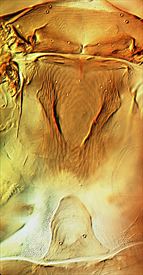Distinguishing features
Both sexes fully winged, Female brown, tarsi yellow, fore tibiae variable with base darker than yellow apex; major setae pale; fore wings shaded, particularly medially. Head longer than wide, bearing up to 7 stout cheek setae; compound eyes similar in size dorsally and ventrally; postocular setae expanded at apex; maxillary stylets close together medially, retracted to postocular setae. Antennae 8-segmented, segment III with 3 sense cones, IV with 4 sense cones. Pronotum with small, scattered discal setae; anteroangular, midlateral, and epimeral setae long, expanded at apex, epimerals longest; posteromarginal setae shorter, bluntly acute; basantra absent; mesopresternum boat-shaped. Metanotum reticulate medially; median setae usually expanded; 2 or 3 pairs of small setae anterior to these. Fore tarsal tooth well developed, variable in size. Fore wing very weakly constricted medially; major sub-basal setae S1 and S2 expanded at apex, S3 longer, acute. Pelta reticulate, elongate, with small lateral lobes; tergite IX posteromarginal setae blunt, less than half as long as tube; tube slender.
Male similar to female, postocular setae longer, cheek setae stouter; pronotum with anteroangular setae longer; median metanotal area raised, with median setae usually acute, and 3–5 pairs of smaller setae on anterior half; tergite IX posteromarginal setae S2 short, stout; sternite VIII with a transverse pore plate. Large males with pronotum more elongate, less sculptured, bearing a stout median longitudinal apodeme, and with anteroangular and epimeral setae longer; fore femora swollen; fore coxae bearing stout setae.
Related species
The genus Hoplandrothrips comprises about 120 species worldwide, particularly in tropical areas, but with nine species recorded from Europe, 16 from Australia, and four from New Zealand. H. choritus is the most commonly collected and widespread Hoplandrothrips in New Zealand, and is recognisable from the reticulate sculpture medially on the metanotum.
Biological data
Apparently associated with Nothofagus forest; found on dead twigs and branches, presumably feeding on fungal hyphae. A few specimens taken on dead Salix branches.
Distribution data
Known only from New Zealand (TO, TK / NN, BR, WD, OL, SL / SI).
Family name
PHLAEOTHRIPIDAE, PHLAEOTHRIPINAE
Species name
Hoplandrothrips choritus Mound & Walker
Original name and synonyms
Hoplandrothrips choritus Mound & Walker, 1986: 56.
References
Mound LA & Walker AK (1986) Tubulifera (Insecta: Thysanoptera). Fauna of New Zealand 10: 1–140.




